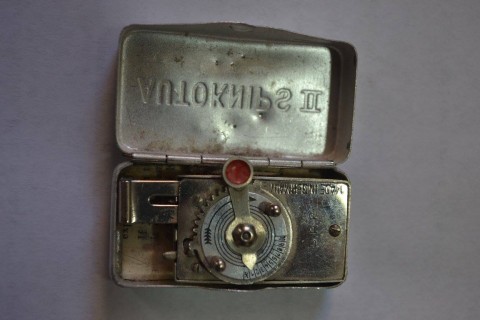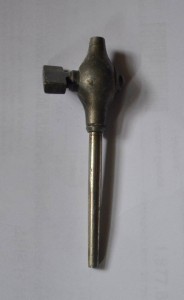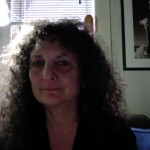
Writing prompts are nothing new, but they can always be helpful in sparking the imagination and generating new content. SmokeLong editor Tara Laskowski recently stumbled across a casual Facebook microfiction writing project that intrigued her—The Tool Project, started by horror writers and editors Ellen Datlow and Kaaron Warren.
The concept? Ellen sends Kaaron a photo of an old and obscure tool (she’s a collector of them) and Kaaron has to write a story about it, without doing any research about its original purpose. They’ve published seven tool stories so far.
Tara caught up with both of them recently for an email Q&A.
How did all this start?
ED: Kaaron and I started chatting on Twitter about my collection of weird tools. She volunteered to write a micro-story about each one I photographed. And so it began.
Tell me more about the tools? Where do you find them?
ED: I have been collecting them for many years. I have no idea why I began. I think I was at a flea market in London’s Covent Garden market and saw a tool that neither I nor the dealer could identify, but it was so pretty I bought it. My rules for buying tools are that they must be interesting looking, cheap, and small.
How many of these weird tools do you have? And where on Earth do you keep them?
ED: I have no idea how many tools I’ve got. They’re spread all over my apartment, displayed on cabinets, windowsills, on my kitchen wall grid (where one hangs pots and pans and other kitchen items that I use regularly). I’m always looking for new, strange (small) tools and objects. They’re not all tools—for example, the metal teeth that Kaaron wrote about.
To me, the most interesting are those that I have no idea of their purpose.
What has surprised you all most about the exercise?
ED: How inventive Kaaron is with her fictions
KW: How many fascinating items Ellen owns.
Kaaron, do you write a lot of flash fiction? Was is it that draws you to this form?
KW: I do write a bit! For my last year of high school, my major project was a series of micro stories. I love that you can be precise and very focussed in this format, and that you don’t always have to have all the answers. I love working to the restraints, as well. For the high school project, each story had to be exactly 50 words.
How many of these tools did you know or could guess their purpose? Did you find it mattered when writing the stories?
KW: Most of them I have a good, if not specific, idea of their purpose, given their design. I tried not to think too hard about their actual purpose, though. I wanted to find the story behind them.

Many of the stories seem to end on these sort of dark, hopeless moments. I especially enjoy the bleakness of the ending of Tool 5. It reminds me of a Twilight Zone episode, and is quite haunting. Do you think the bleakness of the look of the tools themselves lend themselves to bleak stories? Or is that kind of theme/feel what you’re normally drawn to when writing?
KW: I’m definitely drawn to the darker stories in my writing. And, given I’m writing these stories for (with!) Ellen, who is drawn to the same stories, they were always going to be quite bleak.
Any old object carries a certain sadness with it, I think. A reminder that things change, are lost. Each tool has a story behind it and in these stories I’m imagining the past (and, with Tool 5, the future as well). Imagining the people who owned and used these tools. So that brings a bleakness, in a way, because those people are long since dead and gone. Maybe they’ve left behind memories, family, friends. But someone, at some stage, decided the tool (and, we can assume, many of the other belongings) were no longer needed. No longer important.
How many tool stories are you planning on writing?
ED: Depends on time and energy (mostly Kaaron’s). It’s easy for me to photograph each tool, and I doubt I’ll ever run out before her time and energy does 🙂
KW: I’m still enjoying doing them, and I’m finding they are helping me work on other, commissioned stories that I am on deadline for. If ever I’m stuck in a story, I’ll go for a walk, or I’ll sit down and write a bunch of tiny stories like these, because it’s a way for the subconscious to be freed. If you don’t have to worry so much about long plot lines, deep character development, back stories, all that kind of thing, then the idea itself comes to the fore.
I’ve heard people say that it’s hard to write really good funny flash fiction and really good scary flash fiction. Do you agree? What common mistakes do you think people make when trying to write horror flash?
KW: It is tricky, because you don’t have much time for the ‘set-up’, so vital in both funny and scary stories. It can be done, though. You just have to choose your words more wisely.
The most common mistake is people thinking that because they don’t have many words, all they can do is describe something. So they spend the whole 100 words or whatever in a descriptive piece that isn’t actually a story. They’ll use MORE words to describe something than they usually would! I reckon you can tell a story in a short space, but you can’t indulge in descriptive words. You need to be specific, rather.
Read all of the tool stories on Facebook.
 Ellen Datlow has been editing sf/f/h short fiction for over thirty-five years. She was fiction editor of OMNI Magazine and SCIFICTION and currently acquires and edits stories for Tor.com. She has edited almost one hundred anthologies and won multiple awards for her work, including the 2012 Il Posto Nero Black Spot Award for Excellence as Best Foreign Editor. Datlow was named recipient of the 2007 Karl Edward Wagner Award, given at the British Fantasy Convention for “outstanding contribution to the genre”; has been honored with the Life Achievement Award given by the Horror Writers Association, in acknowledgment of superior achievement over an entire career, and the World Fantasy Life Achievement Award for 2014, which is presented annually to individuals who have demonstrated outstanding service to the fantasy field. She lives in New York.
Ellen Datlow has been editing sf/f/h short fiction for over thirty-five years. She was fiction editor of OMNI Magazine and SCIFICTION and currently acquires and edits stories for Tor.com. She has edited almost one hundred anthologies and won multiple awards for her work, including the 2012 Il Posto Nero Black Spot Award for Excellence as Best Foreign Editor. Datlow was named recipient of the 2007 Karl Edward Wagner Award, given at the British Fantasy Convention for “outstanding contribution to the genre”; has been honored with the Life Achievement Award given by the Horror Writers Association, in acknowledgment of superior achievement over an entire career, and the World Fantasy Life Achievement Award for 2014, which is presented annually to individuals who have demonstrated outstanding service to the fantasy field. She lives in New York.
 Award-winning author Kaaron Warren has lived in Melbourne, Sydney, Canberra and Fiji. She’s sold more than 200 short stories, three novels (the multi-award-winning Slights, Walking the Tree and Mistification) and six short story collections including the multi-award-winning Through Splintered Walls. Her latest novel is The Grief Hole (IFWG Publishing Australia, coming out in August) and her latest short story collection is Cemetery Dance Select: Kaaron Warren. She Tweets @KaaronWarren.
Award-winning author Kaaron Warren has lived in Melbourne, Sydney, Canberra and Fiji. She’s sold more than 200 short stories, three novels (the multi-award-winning Slights, Walking the Tree and Mistification) and six short story collections including the multi-award-winning Through Splintered Walls. Her latest novel is The Grief Hole (IFWG Publishing Australia, coming out in August) and her latest short story collection is Cemetery Dance Select: Kaaron Warren. She Tweets @KaaronWarren.

 The core workshop of SmokeLong Fitness is all in writing, so you can take part from anywhere at anytime. We are excited about creating a supportive, consistent and structured environment for flash writers to work on their craft in a community. We are thrilled and proud to say that our workshop participants have won, placed, or been listed in every major flash competition. Community works.
The core workshop of SmokeLong Fitness is all in writing, so you can take part from anywhere at anytime. We are excited about creating a supportive, consistent and structured environment for flash writers to work on their craft in a community. We are thrilled and proud to say that our workshop participants have won, placed, or been listed in every major flash competition. Community works.